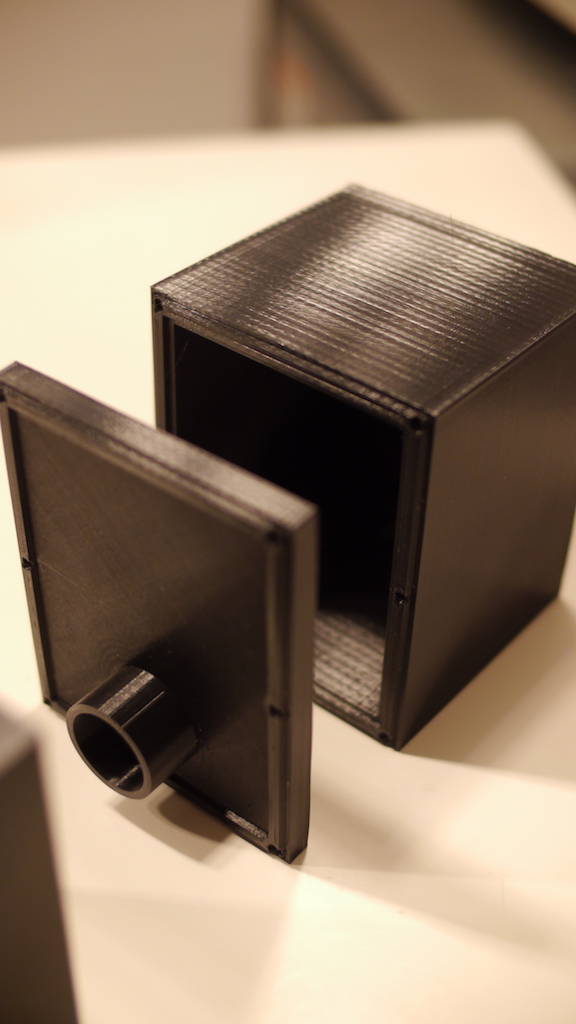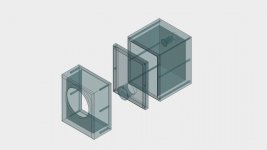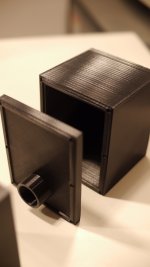If 3D printing you should make shape non planar as standing waves can color sound. Especially backside wall behind driver. Make it angled and riddled with pyramids pointing in and out. But angled back wall not normal to driver will help a lot.
If 3D printing you should make shape non planar as standing waves can color sound. Especially backside wall behind driver. Make it angled and riddled with pyramids pointing in and out. But angled back wall not normal to driver will help a lot.
Great idea! I almost did that, but decided to start simple so I could compare the sound differences of optimized vs less than optimal volumes. Also, I decided to print in 3 pieces since it is faster and uses less "support" material. It would be also nice to experiment with flaring the port ends, but I'm not sure how to compensate by changing the port length accordingly.
Having said all that, the printing is slow. Two pieces are done. The last piece just started printing and won't be done for 36 hours. Fortunately, I'm traveling the next three days, so it will be done when I get back.
Once satisfied with volume, I'd like to experiment with the enclosure design as you suggest. Rounded shapes, fill with clay or other damping materials, flare ports, adding rigidity bracing, etc. All ideas to improve are welcome. As soon as I started printing, I started a design inspired by the B&W Nautilus. 3D printing opens up a lot of possibilities. I may have to get some viscoelastic printing materials for isolating inner enclosures, etc.
Keep the ideas coming...Will post pics when it is finished printing. Then onto measurements...
Here's an interesting quote from another DBR thread regarding enclosure shapes:
Not sure if it is accurate or not, but it is interesting...
However, something to think about from Siegfried Linkwitz: "Some people think that by making the room other than rectangular or using curved surfaces, that they can eliminate standing waves. They merely change frequencies, shift their distribution and make their calculation a lot more difficult."
Whilst he was speaking of room acoustics, the same reasoning is equally applicable to the internals of a speaker cabinet, so it's worth keeping in mind that it's not quite the panacea it's often made out to be. I'm not saying it can never work under any circumstances, just that you might get more benefit from careful selection of materials and construction techniques than from altering the angle of a few box baffles.
Not sure if it is accurate or not, but it is interesting...
DBR and DCR enclosure designs are useful if building floor standing speakers. All enclosures have modal resonances corresponding to their dimensions, just like a room. For woofers, a long enclosure may resonate within the passband of the woofer. For fullrange drivers, the length resonance occurs at a relatively low frequency, requiring a lot of damping material. Splitting the enclosure in sections pushes the resonances much higher, where a smaller amount of damping material can be used.
Looking good! That's a big print and a long time. I usually run into problems like jams or such after more than 12hr jobs.


Don, thanks for the input. I'm guessing my enclosure is so small, the enclosure "rigidity" and standing wave benefits aren't as great as for floor standing DBR/DCR speakers.
XRK971, yes the combined print time for the three pieces was over 50 hours and that was my fastest print setting (Raise 3D N2+ printer). I bought the printer used and the gentleman I bought it from was doing 800 hour prints. I've only have one print fail and that was when a shaft to stepper coupler broke.
This weekend, I hope to work more on a better enclosure shape if the measurements for the volumes and ports look good.
XRK971, yes the combined print time for the three pieces was over 50 hours and that was my fastest print setting (Raise 3D N2+ printer). I bought the printer used and the gentleman I bought it from was doing 800 hour prints. I've only have one print fail and that was when a shaft to stepper coupler broke.
This weekend, I hope to work more on a better enclosure shape if the measurements for the volumes and ports look good.
from David Weems ( I abbreviate and paraphrase).
set the lower freq. of resonance for the box. this should be = to or lower than the calculated Fb for the ideal tuning for your woofer and box vol. There will be another box resonance at abut 2x the frq. of the lower one.
choose port area and length. area of a single tube must be multiplied by 2 to measure the total vent area that interacts with the room.
use the total cu. vol. and 2x the area of one tube to find the duct length from a chart. this length applies to all 3 tubes. you must divide the total vol. so that one chamber has 2x the cu. vol. of the other.
if the dip in response at the 2nd (higher) tuned freq. is noticeable, stuff the port that connects the 2 chambers.
hope this helps
set the lower freq. of resonance for the box. this should be = to or lower than the calculated Fb for the ideal tuning for your woofer and box vol. There will be another box resonance at abut 2x the frq. of the lower one.
choose port area and length. area of a single tube must be multiplied by 2 to measure the total vent area that interacts with the room.
use the total cu. vol. and 2x the area of one tube to find the duct length from a chart. this length applies to all 3 tubes. you must divide the total vol. so that one chamber has 2x the cu. vol. of the other.
if the dip in response at the 2nd (higher) tuned freq. is noticeable, stuff the port that connects the 2 chambers.
hope this helps
note: Weem's "double chambered reflex" also has a port of the front baffle. All 3 ports
are equal in size.
are equal in size.
Hello,
I have spent a few hours to try to find a way to compute a DBR enclosure.
Here are my speculation for discussion.
I believe that one can view the chamber with the speaker, V1, behaving like a sealed chamber to the upper frequencies.
I think it works by setting the internal port tuning frequency to higher that of the external port.
At higher frequencies, the driver doesn't see the second chamber.
Below the tuning frequency of the internal port, the driver just sees one big box.
As an exemple I have used the Faital Pro 5FE120-4.
FaitalPRO | LF Loudspeakers | 5FE120
Step 1
I suggest to select first a suitable Bass-Reflex alignment.
I have used Dominique Petoin's sheet.
Paramètres haut-parleur de THIELE et SMALL, sans filtre ni ampli
I have selected the QB3 alignment.
Press The grey button named "Afficher les valeurs pour votre enceinte Bass-reflex"
This opens a new sheet and you get Vb=4.1 L and Fb=66 Hz
At the end of the sheet Dominique suggest to share Vb in two smaller volumes.
V1=1,65 L and V2=2,45L
Here comes the sun !
Step 2
With the demo version of LspCad, make the simulation of the sealed box V1.
You get Fc=134 Hz
FC is the central frequency of the 4th order bandpass filter done with the internal vent and V2.
As you already know the first f-3 and the central frequency, you get the second f-3 frequency.
So the internal port tuning frequency = 134 Hz + 66 Hz = 200 Hz.
Ok ?
Step 2
You can finish the job and using adequate port diameters you can get the first port length. Still using LspCad just add a port and a temporary radiation. This transform the sealed box in a vented one. Enter the internal port diameter.
I chose a radius of 22mm and entered the internal port tuning frequency: 200 Hz. LspCad is nice enough to give you the port length = 4 cm.
Step 3
Suppress the radiation element and add the second volume V2=2.45 L and the external port and a new radiation element.
Edit the port and enter the tuning frequency: 66 Hz along with a convenient diameter. I have selected again a radius of 22 mm. This gives the external pot length.
And this is it !
You can now simulate the whole thing.
The maximum power is limited by the cone displacement @86 Hz at around 25W that puts around 92dB at 1m not so much 😎 but it is a 4,1 liter box.
The port air speed:
Thank you for your comments good or bad...
I have spent a few hours to try to find a way to compute a DBR enclosure.
Here are my speculation for discussion.
I believe that one can view the chamber with the speaker, V1, behaving like a sealed chamber to the upper frequencies.
I think it works by setting the internal port tuning frequency to higher that of the external port.
At higher frequencies, the driver doesn't see the second chamber.
Below the tuning frequency of the internal port, the driver just sees one big box.
As an exemple I have used the Faital Pro 5FE120-4.
FaitalPRO | LF Loudspeakers | 5FE120
Step 1
I suggest to select first a suitable Bass-Reflex alignment.
I have used Dominique Petoin's sheet.
Paramètres haut-parleur de THIELE et SMALL, sans filtre ni ampli
I have selected the QB3 alignment.
Press The grey button named "Afficher les valeurs pour votre enceinte Bass-reflex"
This opens a new sheet and you get Vb=4.1 L and Fb=66 Hz
At the end of the sheet Dominique suggest to share Vb in two smaller volumes.
V1=1,65 L and V2=2,45L
Here comes the sun !
Step 2
With the demo version of LspCad, make the simulation of the sealed box V1.
You get Fc=134 Hz
An externally hosted image should be here but it was not working when we last tested it.
An externally hosted image should be here but it was not working when we last tested it.
FC is the central frequency of the 4th order bandpass filter done with the internal vent and V2.
As you already know the first f-3 and the central frequency, you get the second f-3 frequency.
So the internal port tuning frequency = 134 Hz + 66 Hz = 200 Hz.
Ok ?
Step 2
You can finish the job and using adequate port diameters you can get the first port length. Still using LspCad just add a port and a temporary radiation. This transform the sealed box in a vented one. Enter the internal port diameter.
An externally hosted image should be here but it was not working when we last tested it.
I chose a radius of 22mm and entered the internal port tuning frequency: 200 Hz. LspCad is nice enough to give you the port length = 4 cm.
Step 3
Suppress the radiation element and add the second volume V2=2.45 L and the external port and a new radiation element.
An externally hosted image should be here but it was not working when we last tested it.
Edit the port and enter the tuning frequency: 66 Hz along with a convenient diameter. I have selected again a radius of 22 mm. This gives the external pot length.
And this is it !
You can now simulate the whole thing.
An externally hosted image should be here but it was not working when we last tested it.
An externally hosted image should be here but it was not working when we last tested it.
An externally hosted image should be here but it was not working when we last tested it.
The maximum power is limited by the cone displacement @86 Hz at around 25W that puts around 92dB at 1m not so much 😎 but it is a 4,1 liter box.
The port air speed:
An externally hosted image should be here but it was not working when we last tested it.
Thank you for your comments good or bad...
Last edited:
An easy way to do this and achieve all the benefits od dbr is to SIM an ordinary bass reflex at half an octave below fs with a 3db hump in response. Then devide that volume by 2 and use that as the volume for the driver chamber (tuned to around 2x low tuning). You will have a 6db hump in frequency for that smaller chamber. You then damp both chamber and port of smaller chamber to an almost flat response.Hello,
I have spent a few hours to try to find a way to compute a DBR enclosure.
Here are my speculation for discussion.
I believe that one can view the chamber with the speaker, V1, behaving like a sealed chamber to the upper frequencies.
I think it works by setting the internal port tuning frequency to higher that of the external port.
At higher frequencies, the driver doesn't see the second chamber.
Below the tuning frequency of the internal port, the driver just sees one big box.
As an exemple I have used the Faital Pro 5FE120-4.
FaitalPRO | LF Loudspeakers | 5FE120
Step 1
I suggest to select first a suitable Bass-Reflex alignment.
I have used Dominique Petoin's sheet.
Paramètres haut-parleur de THIELE et SMALL, sans filtre ni ampli
I have selected the QB3 alignment.
Press The grey button named "Afficher les valeurs pour votre enceinte Bass-reflex"
This opens a new sheet and you get Vb=4.1 L and Fb=66 Hz
At the end of the sheet Dominique suggest to share Vb in two smaller volumes.
V1=1,65 L and V2=2,45L
Here comes the sun !
Step 2
With the demo version of LspCad, make the simulation of the sealed box V1.
You get Fc=134 Hz
An externally hosted image should be here but it was not working when we last tested it.
An externally hosted image should be here but it was not working when we last tested it.
FC is the central frequency of the 4th order bandpass filter done with the internal vent and V2.
As you already know the first f-3 and the central frequency, you get the second f-3 frequency.
So the internal port tuning frequency = 134 Hz + 66 Hz = 200 Hz.
Ok ?
Step 2
You can finish the job and using adequate port diameters you can get the first port length. Still using LspCad just add a port and a temporary radiation. This transform the sealed box in a vented one. Enter the internal port diameter.
An externally hosted image should be here but it was not working when we last tested it.
I chose a radius of 22mm and entered the internal port tuning frequency: 200 Hz. LspCad is nice enough to give you the port length = 4 cm.
Step 3
Suppress the radiation element and add the second volume V2=2.45 L and the external port and a new radiation element.
An externally hosted image should be here but it was not working when we last tested it.
Edit the port and enter the tuning frequency: 66 Hz along with a convenient diameter. I have selected again a radius of 22 mm. This gives the external pot length.
And this is it !
You can now simulate the whole thing.
An externally hosted image should be here but it was not working when we last tested it.
An externally hosted image should be here but it was not working when we last tested it.
An externally hosted image should be here but it was not working when we last tested it.
The maximum power is limited by the cone displacement @86 Hz at around 25W that puts around 92dB at 1m not so much 😎 but it is a 4,1 liter box.
The port air speed:
An externally hosted image should be here but it was not working when we last tested it.
Thank you for your comments good or bad...
The response will give you a great rolloff, great power handling and lower than normal tuning.
Could you post a simulation of both DBR and conventional BR in the same overall volume box, please? Frequency response and cone displacement?
excuse me Freddi could you please show me how you get to this screen? or give me a relevant link. Thank you
horn response will do DBR including twp port - make one port tiny to shut it's effects off

- Status
- Not open for further replies.
- Home
- Loudspeakers
- Full Range
- Full range Double Bass Reflex (DBR) w/FaitalPro 3FE20


